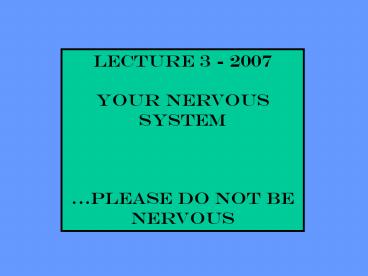YOUR NERVOUS SYSTEM - PowerPoint PPT Presentation
Title:
YOUR NERVOUS SYSTEM
Description:
Afferent. Efferent. Groups of axons. PNS = Nerve. CNS = tracts. Groups of cell bodies. PNS CNS ... PNS ANS Efferent Nerves. Controls the muscles & glands viscera ... – PowerPoint PPT presentation
Number of Views:67
Avg rating:3.0/5.0
Title: YOUR NERVOUS SYSTEM
1
Lecture 3 - 2007 YOUR NERVOUS SYSTEM please
do not be nervous
2
PNS to CNS Sensory signals Eyes, ears, smell
CNS to PNS Skeletal muscle
Viscera to CNS
CNS to PNS
Organization of the Nervous System
3
Efferent
Afferent
Groups of cell bodies PNS CNS
PNS Nerve
Groups of axons
CNS tracts
Ganglia
Nuclei
4
PNS ? ANS ? Efferent Nerves Controls the muscles
glands ? viscera Connects CNS to muscles
(smooth blood vessels, eye, Skin hair
follicles, stomach cardiac heart)
- Parasympathetic
- acts to conserve,
- save energy
- Related to psych
- relaxation
- Sympathetic
- stimulates,organizes
- mobilizes energy in threat
- situations
- Related to psych arousal
Rest digest
Fight or Flight
5
Parasympathetic
Sympathetic
Not mutually exclusive Target organs receive
input from both systems
HB Blood Pressure Digestion
Metabolism of fat glycogen
HB Blood Pressure Digestion
6
(No Transcript)
7
From CNS where do nerves originate?
- Parasympathetic
- (cranio-sacral)
- Brain Stem (Medulla)
- Sacral (S2, S3, S4)
- Sympathetic
- Thoracic (T1-)
- Lombar (L2)
8
- Thoracic (T1-
- Lumbar (L2)
- Travel thru
- 2 ganglia to
- effector organ
- 1st ganglia
- (preganglion)
- SHORT unmyelin
- 2nd ganglia
- (postganglion)
- LONG
- (myelinated)
- Preganglion
- Acetylcholine
Parasympathetic Pathways
Sympathetic
- Brain stem
- Sacral
- Travel thru
- 2 ganglia to
- effector organ
- 1st ganglia
- (preganglion)
- LONG myelin
- 2nd ganglia
- (postganglion)
- SHORT (unmyelinated)
- Preganglion
- Acetylcholine
- Postganglion
9
Functions of the Sympathetic Parasympathetic
(Noradrenergic Receptors)
(Cholinergic Receptors)
Organ Sympathetic Effect Parasympathetic
Effect Salivary Gland decreases
secretion increases secretion Heart increases
heart rate decreases heart rate Blood
Vessels constricts blood vessels dilates blood
vessels Iris radial muscle dilates pupils no
effect Iris
sphincter muscle no effect constricts
pupils Tear Gland no effect stimulates
secretion Sweat Gland stimulates secretion no
effect Stomach Intestine no effect stimulates
secretion Lungs dilates bronchioles constricts
bronhioles Arrector Pili muscle piloerection
no effect Penis ejaculation erection
10
Over-the counter cold meds Sympathomimetics
- Virus invade mucous membranes (Nose)
- Blood vessels dilate swelling
Sympathetic Parasympathetic Blood
Vessels constricts blood vessels!!! dilate blood
vessels Salivary Gland decreases
secretion Increases secretion Heart increases
heart rate decreases heart rate Iris
muscle dilates pupils no effect
Drug Needs to
(pseudoephederine, epinephrine)
mimic the effects of stimulation in the
sympathetic NS
Postganglia? Norepi (Adrenergic) ? Bind to
Adrenergic receptor
11
Asthma medication
- Constriction of Bronchioles
Sympathetic Parasympathetic Lungs dilates
bronchioles constricts bronchioles Salivary
Gland decreases secretion Increases secretion
Heart increases heart rate decreases heart
rate Drug Needs to
Bronchodialator Albuterol
(beta-2 receptor agonist)
12
Sympathetic System Gone Bad
- Essential Hyperhidrosis- excessive sweating
- No single cause
- Over-activity of sympathetic nervous system
- Can be genetically transmitted
- Can first appear in early childhood
- TREATMENT
- Disrupt impulses to the sweat glands
- Block acetylcholine (remember ACh postganglia)
- Destroy the glands or block off their ducts
- so that the sweat cannot flow out onto the skin.
- Familial Dysautomia (FD) no overflow of tears
with emotional crying - Caused by incomplete development of sensory and
autonomic neurons - have inappropriate perceptions heat, pain, and
taste - May sweat and vomit excessively
- It is a Jewish genetic disease
13
Parasympathetic Nerves originating from the
brain stem Cranial Nerves!!! 12 pairs
http//www.gwc.maricopa.edu/class/bio201/cn/crania
l.htm
14
Parasympathetic Nerves originating from the Brain
Stem Cranial Nerves!!! 12 pairs On Old Olympus
Towering Tops A French And German Viewed Some
Hops (Hops smellso1st cranial nerve)
15
Parasympathetic Nerves originating from the
Brain Stem Cranial Nerves Function!!! 12
pairs Some Saps May Marry But My Brother Says
Bad Business My My
16
In class activity Are all your cranial nerves
working????
Nerve Function How to test
I olfaction with an odorous substance
II vision vision chart
III most eye muscles "follow the moving finger"
IV superior oblique look down at the nose
V facial sensation touch the face
muscles of mastication clench the teeth
VI lateral rectus look to the side
VII facial expression smile, raise the eyebrows
taste sugar or salt
VIII hearing a tuning fork
balance look for vertigo
IX pharynx sensation gag reflex
X muscles of larynx and pharynx, parasymp. check for hoarseness, open wide and say "AH"
XI trapezius and sternocleidomastoid test shoulder raise or turning the head
XII tongue muscles stick out the tongue































